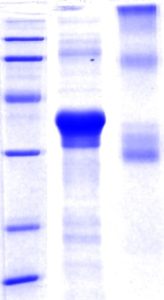Omentin Human E. coli
Omentin (intelectin-1, intestinal lactoferin receptor, endothelian lectin HL-1, galactofuranosebinding lectin) is newly identified secretory protein that is highly and selectively expressed in visceral adipose tissue relative to subcutaneous adipose tissue (adipokine). The mature omentin is secretory glycoprotein consisting of 295 amino acids and 1-linked oligosacharides, and its basic structural unit is a 120-kDa homotrimer in which 40-kDa polipeptides are bridged by disulfide bonds. Omentin has been identified in other tissue at lower expression levels such are Paneth cells, endothelial cells, and visceral adipose stromal-vascular cells. A homolog of omentin has been identified that shares 83% amino acid identity with omentin and was referred to as omentin 2. The two omentin genes, omentin 1 and omentin 2, are localized adjacent to each other in chromosomal region, which has been previously linked to type 2 diabetes in several populations. To determine the impact of obesity-dependent insulin resistance on the regulation of two omentin isoforms, gene expression and plasma levels were measured in lean, overweight, and obese subjects. Omentin-1 was shown to be the major circulating isoform in human plasma. Lean subjects had significantly higher omentin-1 plasma levels than obese and overweight subjects. In addition, higher plasma omentin-1 levels were detected in women compared with men. Plasma omentin-1 levels were inversely correlated with BMI, waist circumference, leptin levels, and insulin resistance as measured by homeostasis model assessment and positively correlated with adiponectin and HDL levels. In summary, decreased omentin-1 levels are associated with increasing obesity and insulin resistance. An independent experiment reported that the addition of recombinant omentin-1 in vitro did not affect basal glucose uptake but did enhance insulin-stimulated glucose uptake in both subcutaneous and omental human adipocytes. Omentin-1 increased Akt phosphorylation in the absence and presence of insulin and may regulate insulin action. A recent study of women with the polycystic ovary syndrome (PCOS) found significantly reduced omentin-1 mRNA expression and protein levels in adipose tissue in overweight PCOS women. In addition, significantly lower plasma omentin-1 levels were detected in these women.
Type
Recombinant
Description
Total 294 AA. MW: 32.7 kDa (calculated). N-terminal His-tag, 14 extra AA (highlighted). The AA sequence is identical to UniProtKB/Swiss-Prot entry Q8WWA0 (AA19–298).
Source
E. coli
Purity
Purity as determined by densitometric image analysis: >90%
SDS-PAGE Gel
12% SDS-PAGE separation of Human Omentin
1. M.W. marker – 14, 21, 31, 45, 66, 97 kDa
2. reduced and heated sample, 5μg/lane
3. non-reduced and non-heated sample, 5μg/lane

Endotoxin
< 1.0 EU/μg
Formulation
Filtered (0.4 μm) and lyophilized in 0.5 mg/mL in 20 mM Tris, 50mM NaCl , pH 8.0
Reconstitution
Add deionized water to prepare a working stock solution of approximately 0.5 mg/mL and let the lyophilized pellet dissolve completely. Filter sterilize your culture media/working solutions containing this non-sterile product before using in cell culture.
Applications
Western blotting
Shipping
At ambient temperature. Upon receipt, store the product at the temperature recommended below.
Storage/Expiration
Store the lyophilized protein at –80 °C. Lyophilized protein remains stable until the expiry date when stored at –80 °C. Aliquot reconstituted protein to avoid repeated freezing/thawing cycles and store at –80 °C for long term storage. Reconstituted protein can be stored at 4 °C for a week.
Quality Control Test
BCA to determine quantity of the protein.
SDS PAGE to determine purity of the protein.
LAL to determine quantity of endotoxin.
Note
This product is intended for research use only.
– Kazama K, Okada M, Yamawaki H. A novel adipocytokine, omentin, inhibits monocrotaline-induced pulmonary arterial hypertension in rats. Biochem Biophys Res Commun. 2014 Sep 12;452 (1):142-6
– Kazama K, Okada M, Yamawaki H. Adipocytokine, omentin inhibits doxorubicin-induced H9c2 cardiomyoblasts apoptosis through the inhibition of mitochondrial reactive oxygen species. Biochem Biophys Res Commun. 2015 Feb 20;457 (4):602-7
– Kazama K, Usui T, Okada M, Hara Y, Yamawaki H. Omentin plays an anti-inflammatory role through inhibition of TNF-alpha-induced superoxide production in vascular smooth muscle cells. Eur J Pharmacol. 2012 Jul 5;686 (1-3):116-23
– Yamawaki H, Tsubaki N, Mukohda M, Okada M, Hara Y. Omentin, a novel adipokine, induces vasodilation in rat isolated blood vessels. Biochem Biophys Res Commun. 2010 Mar 19;393 (4):668-72

